Jaguar E-Pace VS Ford Puma – Specs, Efficiency & Price Comparison
Which model is the better choice – the Jaguar E-Pace or the Ford Puma? We compare performance (269 HP vs 168 HP), boot capacity (494 L vs 523 L), efficiency (1.40 L vs 13.10 kWh5.40 L), and of course, the price (32400 £ vs 24800 £).
Find out now which car fits your needs better!
The Jaguar E-Pace (SUV) is powered by a Plugin Hybrid, Diesel MHEV or Petrol MHEV engine and comes with a Automatic transmission. In comparison, the Ford Puma (SUV) features a Petrol MHEV or Electric engine and a Manuel or Automatic gearbox.
When it comes to boot capacity, the Jaguar E-Pace offers 494 L, while the Ford Puma provides 523 L – depending on what matters most to you. If you’re looking for more power, you’ll need to decide whether the 269 HP of the Jaguar E-Pace or the 168 HP of the Ford Puma suits your needs better.
There are also differences in efficiency: 1.40 L vs 13.10 kWh5.40 L. In terms of price, the Jaguar E-Pace starts at 32400 £, while the Ford Puma is available from 24800 £.
Compare all the key specs now and find out which model fits your lifestyle best!
Jaguar E-Pace
The Jaguar E-Pace is a compact SUV that combines the brand's signature luxury with a dynamic driving experience. Its sleek design features graceful lines and an assertive stance, making it a standout on any road. Inside, the E-Pace boasts a meticulously crafted interior with high-quality materials and advanced technology, providing both comfort and connectivity for drivers and passengers alike.
details @ media.jaguar.com
@ media.jaguar.com
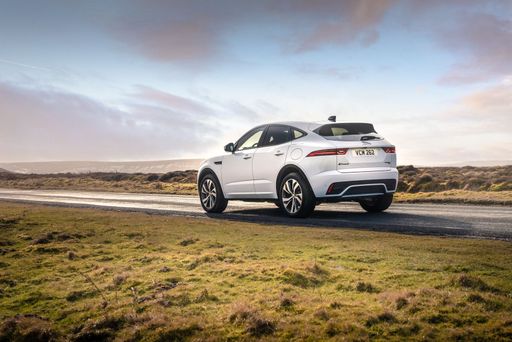 @ media.jaguar.com
@ media.jaguar.com
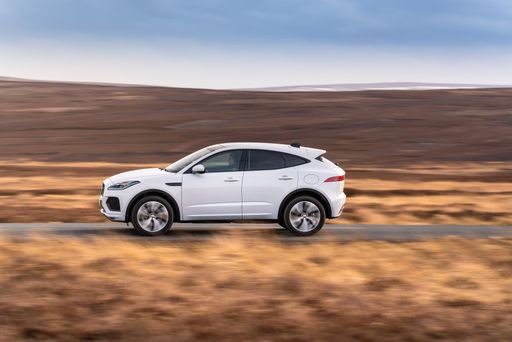 @ media.jaguar.com
@ media.jaguar.com
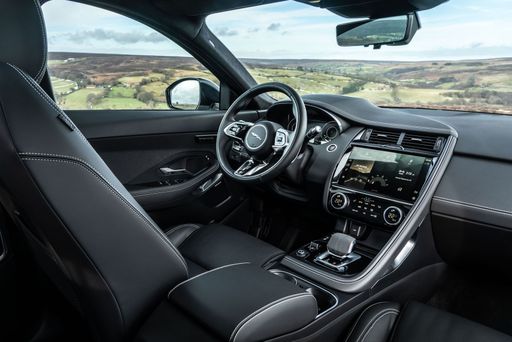 @ media.jaguar.com
@ media.jaguar.com
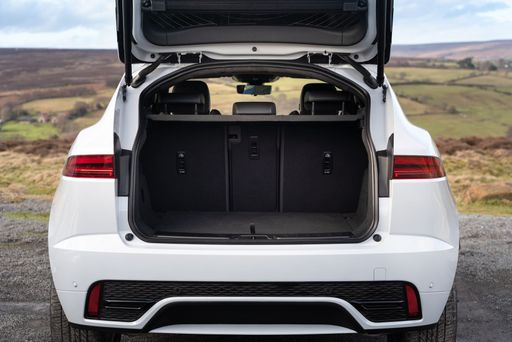 @ media.jaguar.com
@ media.jaguar.com
Ford Puma
The Ford Puma presents itself as a stylish compact SUV with a distinctive design that combines practicality with a dynamic driving experience. Its sleek lines and sporty aesthetics make it stand out on the road, while the interior offers a comfortable and tech-savvy environment. With an emphasis on efficiency and a smooth drive, the Ford Puma is well-suited for both urban commutes and countryside adventures.
details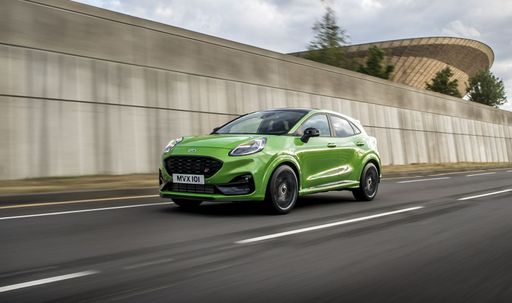 @ puma.fordpresskits.com
@ puma.fordpresskits.com
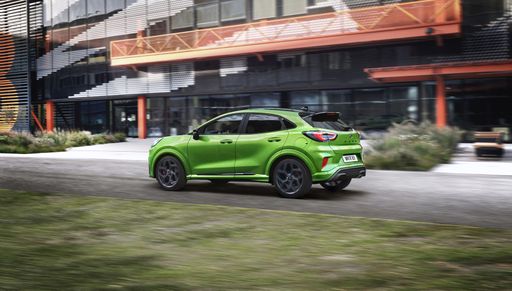 @ puma.fordpresskits.com
@ puma.fordpresskits.com
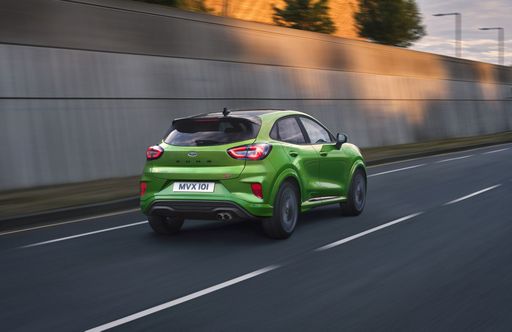 @ puma.fordpresskits.com
@ puma.fordpresskits.com
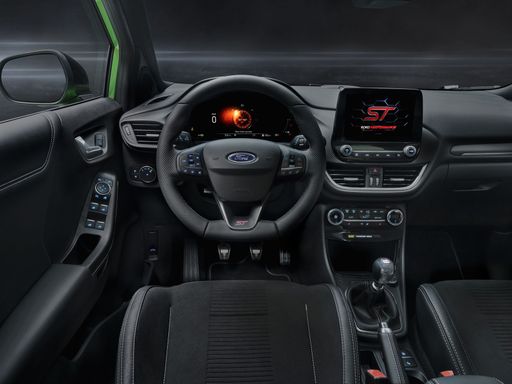 @ puma.fordpresskits.com
@ puma.fordpresskits.com

|

|
|
|
|
Costs and Consumption |
|
|---|---|
|
Price
32400 - 56100 £
|
Price
24800 - 36300 £
|
|
Consumption L/100km
1.4 - 8.2 L
|
Consumption L/100km
5.4 - 6 L
|
|
Consumption kWh/100km
-
|
Consumption kWh/100km
13.1 - 13.7 kWh
|
|
Electric Range
69 km
|
Electric Range
364 - 376 km
|
|
Battery Capacity
11.50 kWh
|
Battery Capacity
43 kWh
|
|
co2
33 - 185 g/km
|
co2
0 - 136 g/km
|
|
Fuel tank capacity
56 - 67 L
|
Fuel tank capacity
42 L
|
Dimensions and Body |
|
|---|---|
|
Body Type
SUV
|
Body Type
SUV
|
|
Seats
5
|
Seats
5
|
|
Doors
5
|
Doors
5
|
|
Curb weight
1783 - 2173 kg
|
Curb weight
1316 - 1563 kg
|
|
Trunk capacity
494 L
|
Trunk capacity
456 - 523 L
|
|
Length
4395 mm
|
Length
4186 - 4226 mm
|
|
Width
1984 mm
|
Width
1805 mm
|
|
Height
1648 mm
|
Height
1550 - 1555 mm
|
|
Payload
497 - 554 kg
|
Payload
367 - 469 kg
|
Engine and Performance |
|
|---|---|
|
Engine Type
Plugin Hybrid, Diesel MHEV, Petrol MHEV
|
Engine Type
Petrol MHEV, Electric
|
|
Transmission
Automatic
|
Transmission
Manuel, Automatic
|
|
Transmission Detail
Automatic Gearbox
|
Transmission Detail
Schaltgetriebe, Automat. Schaltgetriebe (Doppelkupplung)
|
|
Drive Type
All-Wheel Drive, Front-Wheel Drive
|
Drive Type
Front-Wheel Drive
|
|
Power HP
160 - 269 HP
|
Power HP
125 - 168 HP
|
|
Acceleration 0-100km/h
7.3 - 10.5 s
|
Acceleration 0-100km/h
7.4 - 9.8 s
|
|
Max Speed
190 - 211 km/h
|
Max Speed
160 - 210 km/h
|
|
Torque
260 - 540 Nm
|
Torque
170 - 290 Nm
|
|
Number of Cylinders
3 - 4
|
Number of Cylinders
3
|
|
Power kW
118 - 198 kW
|
Power kW
92 - 124 kW
|
|
Engine capacity
1498 - 1998 cm3
|
Engine capacity
999 cm3
|
General |
|
|---|---|
|
Model Year
2024
|
Model Year
2024 - 2025
|
|
CO2 Efficiency Class
B, G
|
CO2 Efficiency Class
D, E, A
|
|
Brand
Jaguar
|
Brand
Ford
|
Jaguar E-Pace
The Jaguar E-Pace: A Modern Marvel in Compact SUV Design
The Jaguar E-Pace stands as a testament to the evolution of compact SUVs, merging classic design elements with cutting-edge technology. For those who appreciate the Jaguar pedigree, the E-Pace offers a blend of performance, style, and practicality that is hard to rival in its class.
Performance and Powertrain Options
Under the bonnet, the Jaguar E-Pace showcases a range of powertrains that cater to various driving preferences. Potential buyers can choose from plug-in hybrids, diesel mild-hybrids, and petrol mild-hybrids, each offering a unique balance of efficiency and power. The available engine options span from 160 to 269 PS, ensuring that drivers can select a model that suits their need for speed and fuel efficiency. Across the range, the acceleration from 0-100 km/h varies between a brisk 7.3 seconds to a more leisurely 10.5 seconds, showcasing versatility in design to meet different driving styles.
Innovative Hybrid Technologies
Jaguar's commitment to sustainability is evident in the E-Pace's hybrid offerings. The P270e Plug-in Hybrid variant combines performance with eco-friendly engineering, boasting a remarkable fuel consumption of just 1.4 L/100km and an all-electric range of up to 69 km. Meanwhile, the diesel mild-hybrids provide a balanced mix of efficiency and traditional power, catering to those who favour diesel engines' long-haul credibility with carbon emissions ranging from a low 33 g/km.
Dynamic Handling and Intelligent All-Wheel Drive
Driving dynamics are at the heart of the E-Pace's design. Jaguar's Intelligent All-Wheel Drive ensures optimal performance across various terrains, enhancing both stability and agility. For those seeking a dynamic driving experience, the R-Dynamic packages add a sporty flair, elevating both aesthetic and on-road performance.
Interior Sophistication and Practicality
The interior of the E-Pace reflects Jaguar's attention to detail, offering a meticulously crafted cabin that combines luxury with functionality. Supporting up to five passengers comfortably, it provides advanced infotainment systems and high-quality materials throughout. The 494-litre boot space ensures ample room for luggage, making it a practical choice for everyday use or weekend getaways.
A Focus on Safety and Driver Assistance
Safety remains at the forefront of the E-Pace's features, with an array of driver-assistance systems designed to enhance security and ease of driving. From adaptive cruise control to lane-keeping assist, the vehicle is equipped to handle the demands of modern motoring.
Conclusion: The Ideal Compact SUV
The Jaguar E-Pace is more than just a statement of style; it's a comprehensive package that addresses the needs of the modern driver. With a price range from €37,800 to €65,500, the E-Pace strikes a balance between luxury and practicality, making it a compelling choice in the competitive compact SUV market.
Ford Puma
A Glimpse into the Ford Puma: Fusing Style with Innovation
The Ford Puma stands as a testament to modern engineering fused with style. This compact SUV is not just about aesthetics but brings to the table an array of technical innovations, topped with the reliability and performance Ford is known for. Let's delve into the technical specifics and innovative features that make the Ford Puma a stellar choice for any car enthusiast.
Powertrains and Performance
The Ford Puma is offered with a range of powertrains designed to deliver optimal performance whilst minimising fuel consumption. At the heart of this compact SUV is the 1.0 EcoBoost Hybrid engine, available in both 125 PS and 155 PS variants. This engine is a marvel of engineering, optimised to deliver power efficiently with a remarkable fuel consumption ranging from 5.4 to 5.7 L/100km for manual versions, and slightly higher for the automated variants.
The top-end 1.5 EcoBoost ST variant takes performance up a notch, providing a robust 200 PS that propels the Puma from 0 to 100 km/h in just 6.7 seconds. This variant is perfect for those who prioritise performance and exhilaration in their driving experience.
Mild-Hybrid Technology
The Puma's mild-hybrid technology plays a significant role in enhancing fuel efficiency and reducing emissions. By utilising a belt-driven integrated starter/generator, the Puma recovers energy usually lost during braking, storing it in a 48-volt lithium-ion battery. This stored energy is then used to assist the engine, providing a boost during acceleration and smoothing out the stop-start technology, ultimately leading to enhanced fuel efficiency.
Design and Comfort
The Ford Puma does not compromise on style and comfort with its ergonomic and stylish design. The SUV is available in multiple trims including the ST-Line, Titanium, and the luxurious Vignale editions, each offering unique aesthetic and technological enhancements. These trim levels provide varied offerings in terms of both exterior styling and interior comfort, ensuring there's a Puma that meets every personal preference.
Inside, the Puma offers a driver-focused cockpit with advanced technological integrations such as the SYNC 3 infotainment system, providing seamless connectivity and intuitive control of the vehicle's numerous technological features.
Safety and Technology
Safety remains paramount, and the Ford Puma is equipped with the latest security and technology features. It boasts the Ford Co-Pilot360 suite which includes adaptive cruise control, pre-collision assist with autonomous emergency braking, and lane-keeping assist, enabling a safer driving experience on both city roads and highways.
Versatility and Practicality
Beyond performance and safety, the Ford Puma shines in its versatility. With a boot capacity of 456 litres, it offers ample space for all sorts of adventures, whether you're heading on a family trip or loading sports equipment. Its innovative MegaBox is an extra storage solution, providing additional space below the boot floor.
The Puma's agile handling, paired with its compact dimensions—spanning a length of 4186 to 4266 mm and a width of 1805 mm—makes it an ideal choice for urban commuting and beyond.
Conclusion
In conclusion, the Ford Puma beautifully blends practical features with cutting-edge technology, offering a package that appeals to both the tech-savvy driver and those seeking comfort and reliability. Its range of innovative features, powerful yet efficient engine options, and a design that is both functional and stylish make it a frontrunner in the compact SUV market.
Whether you're drawn by the efficient mild-hybrid engines or the robust performance of the ST variant, the Ford Puma represents a modern driving experience where innovation meets everyday usability.
The prices and data displayed are estimates based on German list prices and may vary by country. This information is not legally binding.
